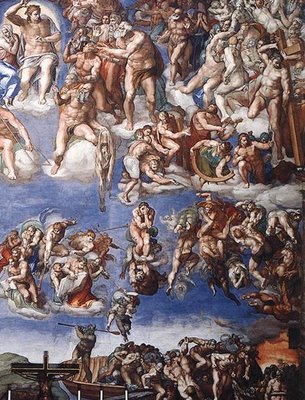As I mentioned before, I’ve started going over the Didache series from the Midwest Theological Forum. I haven’t gotten as far as I’d like to have at this point, but thus far I can say the series is what I’d hoped it would be. Further, the books clearly are put together to survive the beating textbooks in the hands of students tend to take; the binding is tight, the cover sturdy and the pages thick enough to withstand accidental ripping. The text is also large enough to not cause eye strain when reading many pages at a sitting, and nearly every page has artwork to augment the text flow. Maybe it’s just that I like things over-engineered a little, but I’d say this is well done.
But, I’m not just making this entry to talk about book construction. In the first book in the series’ section on the Church there is a discussion of the Final Judgement; this is something we just don’t hear about much. Personally, I don’t think that’s a good thing. Certainly, Deus caritas est (the concept, not the encyclical) is important, but at a generic level it is not all-encompassing. Every once in a while we need to be reminded that there will come a time when we have to answer for what we have done, both the good and the bad. It is then that we will come to know for certain the answers to those nagging questions and our worries and fears will be answered. From the book:
At the general judgement, God’s majesty, wisdom, justice, and mercy will shine forth for all to see as Jesus Christ’s final victory on earth. We will see why God sometimes allows the good to suffer and the wicked to prosper. We will also see all the good and bad effects of humans’ actions. Souls will be reunited to their now immortal bodies in the resurrection. The bodies of the saints will be beautiful and luminous while the bodies of the damned will be hideous and dark. At this point Jesus will tell the good to come into the Kingdom of Heaven while sending the wicked into “the eternal fire prepared for the devil and his angels.”
Now, take that statement and line it up directly beside an image of Michelangelo’s Last Judgement from the Sistine Chapel (which I will post here when I can convince Gimp to give me what I want) where we see Jesus as the Just Judge with the Saints in Heaven, calling up the chosen people and casting down to Hell the damned. Is the everlasting life really that binary? To pull a quote from Father Corapi‘s introduction on his many videos, “at the end, forever, you and I will be in Heaven or Hell. Period.” It doesn’t get much more simple than that, now does it?
Update: This is the image they use in the book. Notice that it includes St. Bartholomew holding his flayed skin, reminding us of the lengths to which we can be called in our faith. Could you withstand that? Could I?





